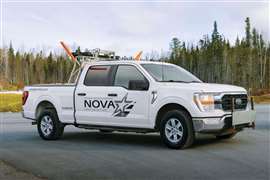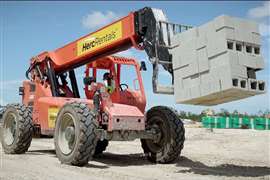Reducing your carbon footprint
15 July 2013

Reducing fuel consumption during crane operation is one way that manufacturers are actively reducing the impact their products have on the environment. Liebherr introduced several technologies to decrease fuel consumption during crane operations, as Wolfgang Beringer, spokesman at Liebherr-Werk Ehingen, explains, “Several years ago we introduced new transmissions with a high number of gears and a dry clutch instead of a torque converter. The result of this is a 10 to 15% fuel saving when driving on the road. At Bauma we also presented the Eco-mode for crane operation which results in a fuel saving of up to 10%.”
The Eco-mode works by reducing the engine speed to a required, predefined level. “With this feature a reduction of diesel consumption can be achieved without any impact on operational output,” adds Tobias Froehlich at Liebherr-Werk Nenzing.
Fuel reduction technology from Tadano includes the Fuel Monitoring System, which displays fuel consumption; the Eco Mode, which reduces fuel use by controlling engine acceleration; and finally Positive Control, which uses less fuel by controlling the hydraulic pump and motor for greater fuel efficiency and lower noise.
Hiab has also met the fuel-saver demand by introducing the Multilift XR18. The crane saves fuel because the hooklift can be lowered almost without using the hydraulic pump. “Compared to a hooklift without these features, emissions and fuel consumption during operation for the Hiab Multilift XR18S on a 3-axle truck is cut by approximately 30% for an average operator,” explains Lotta Clausen, communications director Hiab.
Auto idle stop (AIS) functions are another way to help save fuel consumption. Crane models from manufacturer Kobelco are installed with an AIS system, which detects when the crane is idling and automatically shuts off the engine to avoid wasting fuel. The Grove GMK6400 has a similar function called the Fuel Saver Option, which is a system that reduces fuel consumption during idling. The system works by reducing Engine speed while the machine is at rest and eventually disconnects the pumps completely, shutting the engine down to save fuel. The feature won Manitowoc the Innovation Manufacturer award from the European Association of Abnormal Road Transport and Mobile Cranes (ESTA) at this years’ Bauma exhibition.
Instead of an AIS function, Unic cranes have a throttle control for the power output, so the minimum amount of energy is used. “When the machine is idling, the engine quickly returns to running at its lowest possible speed to conserve energy,” explains a GGR Group spokesperson. In addition to these systems, smaller crane models also have reusable washable filters to help reduce their impact on the environment.
Kitting out the crane
Crane rental companies are also putting measures in place to reduce the impact their crane operations have on the environment. In case of hydraulic hose ruptures, for example, TNT Crane Rental equips its fleet with spill kits. The kits consist of a 5 gallon bucket which is filled half way with oil absorbent granules to pour on an oil spill, an oil boom to put around a drain and oil absorbers to wrap around leaking hoses.
“Our operators are trained how to control a spill and minimise any environmental damage. These kits are for immediate action should we have an oil leak. When a spill occurs the service department is immediately dispatched to the scene with the proper equipment to contain and clean up the spill,” explains Randy Dobbs, TNT Crane Rental.
Tyres are another factor that can have a negative impact on the environment. Statistics from the Environmental Agency state that in the UK around 55 million tyres are put to waste every year. Used tyres, however, can be recycled in a number of ways, including re-moulding. In the UK alone, 11 per cent of used tyres were re-treaded and put back on the road in 2010.
Focusing on recycling, Continental Tyres has introduced the Continental LifeCycle tyre, a tyre made out of recycled tyre casings. For the re-moulding process 65% of the old tyre is reused and 35% of new raw material is added. “With customers’ help this large-scale recycling initiative will help bring down the number of scrap tyres needing disposal and reduce CO2 emissions,” a company spokesperson from Continental said. Alongside this project, Continental is researching the possibilities of using Russian dandelions as an alternative source for natural rubber instead of rubber trees. Potentially the material could be used for all tyre applications.
Electric avenue
Producing zero emissions and zero noise pollution is another trend that is picking up throughout the industry and as a result electric cranes are becoming a popular choice for end users. Aimed for this market, Italian crane manufacturer Galizia has manufactured the GF400 battery-electric pick and carry crane. The GF400 has a capacity of 40 tonnes, a compact chassis and comes with radio remote control for traction, steering, boom and winch functions. It also has removable counterweights. In addition, Bailey Crane has also introduced a hybrid electric drive system for their cranes division. “The hybrid drive provides workers and the environment with clean, quiet and safe lifting equipment and reduces the potential for carbon monoxide poisoning,” a company spokesperson said.
Also aimed at reducing emissions, Unic Cranes Europe offers the battery powered Eco-095 spider crane on wheels. The 0.995 tonne capacity Eco-095 mini crane and the higher capacity 2.9 tonne Eco-295 model have a rechargeable 48 v battery, which provides power for 2.5 hours of continuous operation. They have been developed by Japanese manufacturers Furukawa Unic for use in sensitive environments, such as historical sites, churches and museums. The models are 750 mm wide and can be transported in a goods elevator, moved through a standard doorway and controlled using radio remote. Additionally, Unic mini cranes can be supplied with an LPG power option (liquefied petroleum gas) which only releases non-toxic fumes. Filtration systems can be also fitted to the crane’s diesel engine.
Graeme Riley, CEO Unic Cranes Europe said, “The Eco-095 meets the demand from customers and principal contractors for a more environmentally friendly lifting solution that helps to reduce their carbon footprint without compromising on effectiveness. It provides a perfect alternative for lifting in confined areas where diesel or LPG powered cranes aren’t suitable.
The Liebherr Pactronic System
To reduce negative impacts on the environment, manufacturer Liebherr has produced the Liebherr Pactronic System, a hybrid drive system that boosts primary power using a secondary source. The name Pactronic comes from Power by Accumulator and Electronics. Instead of increasing the primary power, boosting power is achieved by adding a secondary energy source to the system, or an additional energy storage device (accumulator). The accumulator is charged by using reverse power while lowering a load and by the surplus power of diesel engine. The energy, which is stored in the compressed gas, can be released upon demand and provides additional power for the drive system. As a result, the total hoisting power is the sum of the conventional hydrostatic power and the secondary energy, which is provided by the accumulator.
“In order to reach an optimal efficiency, a hydraulic motor is directly coupled to the hoisting winch. In this way, an enormous power boost is possible and both hoisting, as well as lowering, speeds are increased significantly without an increase in primary power,” explains Wolfgang Pfister, LWN.
“When comparing the Pactronic drive system with a conventional Liebherr mobile harbour crane with identical prime mover (diesel or electric engine) installed, hoisting power is doubled, resulting in an increased hoisting and lowering with up to 100% higher speeds,” Pfister adds. “With a focus on turnover (tonnes/hour), the end user benefits from an increase in performance of 30% on average depending on the crane’s operation mode.”
Factory settings
Crane manufacturers are also reducing environmental impacts during the production phase. Typical examples are less waste in manufacturing and products with lower engine emissions. Crane manufacturer Liebherr, for example, has enforced strict policies at its Liebherr-Werk Nenzing factory, which is in a protected area in Nenzing, Austria. Tobias Froehlich, Liebherr-Werk Nenzing strategic marketing and communications, explains that as a result of its location, the site has to meet high environmental standards. To help protect the surrounding area, water-based paint and natural gas are used in the production process. In addition, the production of crawler crane boom sections is automated and work is carried out at the centre of the factory to reduce the transport route from 3.5 km to 400 metres.
Similar energy-saving policies are in place at Liebherr-Werk Biberach in Germany where power is generated by solar panels that cover approximately 30,000 square metres on the factory roof. “Every year the system generates close on 2.6 million kWh of electricity and results in Carbon dioxide savings of approximately 2,500 tonnes per year,” explains Daniela Schoene, Liebherr-Werk Biberach.
Crane manufacturer Tadano is also reducing energy consumption through the installation of solar panels. The roof of its Shido plant in Kagawa Prefecture, Japan, has been installed with 2,000 square metres of solar panels. According to Tadano’s latest figures, in 2010 the panels produced 255,740 kWh of energy. Tadano Faun in Germany is also ISO14001 certified and the company uses water-based paint for primer coats during production.
Reducing carbon dioxide emissions is a well-known topic of discussion for crane manufacturers. Palfinger is actively reducing the company’s carbon dioxide emissions, as a company spokesperson explains, “We follow guidelines to guarantee energy efficiency, waste reduction, safe disposal and compliance with environmental provisions into local management. Some of our sites, such as Lengau and Köstendorf in Austria already have certified environmental management systems in place. Caxias do Sul in Brazil and Tenevo in Bulgaria are already preparing for the introduction of such systems.” The company also uses solvent-free paints during the production process.
Also actively reducing its carbon dioxide emissions is Cargotec. In 2012 Cargotec’s greenhouse gas emissions totalled approximately 39,000 carbon dioxide equivalent tonnes and the total amount of waste was approximately 11,700 tonnes, most of which was recyclable. To meet these levels, the company has a policy that focuses on reducing energy consumption. In addition, most of Cargotec's Hiab crane factories have been certified to ISO 14001, an environmental standard which helps companies reduce waste management and minimise consumption of energy and materials through the use of an environmental management system.
To minimise waste and energy consumption crane manufacturer Kobelco has fewer production lines and more automatic processing machines at its factories. It also imposes a strict inspection policy on all its products before shipment to prevent pollution. A company spokesperson explains, “We examine all chemical substances contained in the parts of typical models among those specified for European market, to verify that our machines do not contain toxic substances exceeding the levels defined by the strict European REACH standard. Registration, Evaluation, Authorization and Restriction of Chemicals (REACH) is a European Union regulation governing all range of products, and is the most strict regulation of its kind today.”






